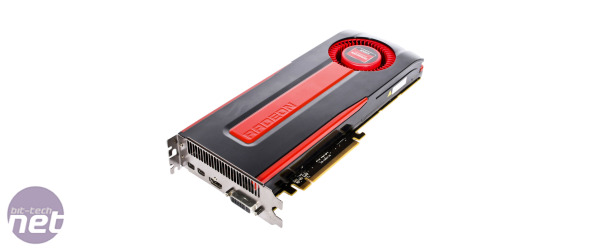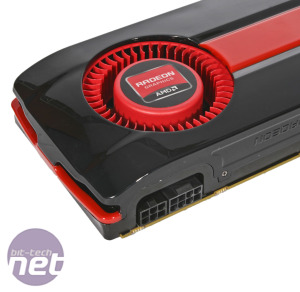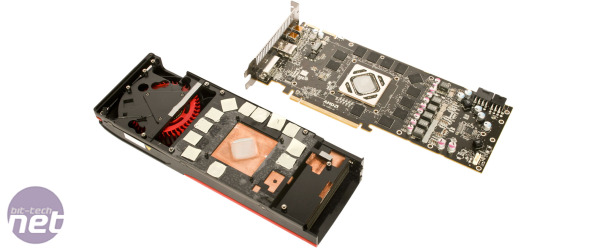
Manufacturer: AMD
UK Price (as reviewed): £400 (inc VAT) (estimated)
US Price (as reviewed): $499 (ex TAX)
It’s fair to say that AMD hasn’t been having the GPU market all its way this year. Despite being first to market with its 28nm GPUs and quickly filling out its product range with South island architecture GPUs, Nvidia’s response in the form of the GTX 680 2GB and GTX 670 2GB has been extremely robust. So much so that at the top end of graphics, it became less a question of Nvidia vs. AMD and more a case of ‘which Nvidia card should you buy?’ The only saving grace looked to be Nvidia’s glacier-like pace in bringing a mid-range card to market, allowing the HD 7870 2GB and HD 7850 2GB some much needed breathing room.

Click to enlarge - Look familiar? It should do, as its physically identical to the original HD 7970 3GB
With no sign of the (still expected) dual-GPU 7990, AMD has refused to surrender this round to team green and the HD 7970 3GB GHz edition is its latest counter-blow. However, its fair to say it’s not the most spectacular of new product announcements.
Physically at least, the HD 7970 3GB GHz Edition is identical to the HD 7970 3GB we first reviewed six months ago today. Put a GHz Edition next to a standard 7970 3GB and you’d have no way of differentiating other than the silver GHz edition sticker AMD has popped onto the card’s radial fan.
That means the card still measures 275mm in length and occupies a pair of expansion slots. To the rear there’s the same DVI, HDMI and 2 x DisplayPort display outputs, and it even requires the same power connections; 1 x 8-pin PCI-E and 1 x 6-pin PCI-E.


Click to enlarge - the GHz Edition has the same rear I/O and power connector requirements of the original HD 7970 3GB
So, just what has AMD changed you might ask? The answer is simply, not a lot. The HD 7970 GHz Edition still uses the exact same Tahiti XT GPU based around 128 SIMD engines of 14 stream processors each, for a total of 2,048 stream processors and the same 384-bit memory bus. While the chip is the same though, it’s the clock speeds that been improved, and in quite a familiar way.
The original HD 7970m 3GB shipped with a set core clock speed of 925MHz. Since then, Nvidia has moved the GPU frequency goal-posts with its GPU-boost technology and despite some initial nay-saying, AMD has gotten in on the turbo-boosting action with the HD 7970 3GB GHz Edition. Shipping with a base clock of 1GHz (who’d have thought!), it’s able to boost up to 1,050MHz given the right circumstances. However, unlike Nvidia’s cards which actively report clock speeds in real-time, AMD offers no such option with the 7970 3GB GHz Edition, leaving us somewhat in the dark as to when the card is and isn’t boosting.

Click to enlarge - The cooler, PCB and power circuitry are the same too. Its simply an overclocked HD 7970 3GB.
Regardless, the 125MHz overclock (13.5 per cent) is still a notable increase, although it’s not too far away from what AMD’s board partners already offer via pre-overclocked versions of the HD 7970 3GB. Back in our initial review of the HD 7970 3GB, we easily managed to overclock the card to 1,125MHz, so clearly AMD is still leaving some room to overclock the GHz Editon too. Interestingly though, overclocking the card only increases the boost clock, not the base clock, allowing the card to pass worst-case thermal tests such as Furmark, and still boost.
The memory has also received a boost, with an increased frequency of 1.5GHz (6GHz effective), matching that of the GTX 680 2GB. However, as the HD 7970 3GB offers a much larger 384-bit memory bus, the resultant memory bandwidth is a monster 288GB/s, compared to the 192.26GB/sec of the GTX 680 2GB.
Alongside the HD 7970 3GB it’s also launched its new Catalyst 12.7 beta driver and we’ve found it to dramatically improve performance for all the 7-series cards across a range of benchmarks. With just its overclock we were sceptical of the GHz edition making much of a dent in the GTX 680 2GB’s position, but, as you’ll see, the new Catalyst driver levels the graphics playing field a great deal.
UK Price (as reviewed): £400 (inc VAT) (estimated)
US Price (as reviewed): $499 (ex TAX)
It’s fair to say that AMD hasn’t been having the GPU market all its way this year. Despite being first to market with its 28nm GPUs and quickly filling out its product range with South island architecture GPUs, Nvidia’s response in the form of the GTX 680 2GB and GTX 670 2GB has been extremely robust. So much so that at the top end of graphics, it became less a question of Nvidia vs. AMD and more a case of ‘which Nvidia card should you buy?’ The only saving grace looked to be Nvidia’s glacier-like pace in bringing a mid-range card to market, allowing the HD 7870 2GB and HD 7850 2GB some much needed breathing room.

Click to enlarge - Look familiar? It should do, as its physically identical to the original HD 7970 3GB
With no sign of the (still expected) dual-GPU 7990, AMD has refused to surrender this round to team green and the HD 7970 3GB GHz edition is its latest counter-blow. However, its fair to say it’s not the most spectacular of new product announcements.
Physically at least, the HD 7970 3GB GHz Edition is identical to the HD 7970 3GB we first reviewed six months ago today. Put a GHz Edition next to a standard 7970 3GB and you’d have no way of differentiating other than the silver GHz edition sticker AMD has popped onto the card’s radial fan.
That means the card still measures 275mm in length and occupies a pair of expansion slots. To the rear there’s the same DVI, HDMI and 2 x DisplayPort display outputs, and it even requires the same power connections; 1 x 8-pin PCI-E and 1 x 6-pin PCI-E.


Click to enlarge - the GHz Edition has the same rear I/O and power connector requirements of the original HD 7970 3GB
So, just what has AMD changed you might ask? The answer is simply, not a lot. The HD 7970 GHz Edition still uses the exact same Tahiti XT GPU based around 128 SIMD engines of 14 stream processors each, for a total of 2,048 stream processors and the same 384-bit memory bus. While the chip is the same though, it’s the clock speeds that been improved, and in quite a familiar way.
The original HD 7970m 3GB shipped with a set core clock speed of 925MHz. Since then, Nvidia has moved the GPU frequency goal-posts with its GPU-boost technology and despite some initial nay-saying, AMD has gotten in on the turbo-boosting action with the HD 7970 3GB GHz Edition. Shipping with a base clock of 1GHz (who’d have thought!), it’s able to boost up to 1,050MHz given the right circumstances. However, unlike Nvidia’s cards which actively report clock speeds in real-time, AMD offers no such option with the 7970 3GB GHz Edition, leaving us somewhat in the dark as to when the card is and isn’t boosting.

Click to enlarge - The cooler, PCB and power circuitry are the same too. Its simply an overclocked HD 7970 3GB.
Regardless, the 125MHz overclock (13.5 per cent) is still a notable increase, although it’s not too far away from what AMD’s board partners already offer via pre-overclocked versions of the HD 7970 3GB. Back in our initial review of the HD 7970 3GB, we easily managed to overclock the card to 1,125MHz, so clearly AMD is still leaving some room to overclock the GHz Editon too. Interestingly though, overclocking the card only increases the boost clock, not the base clock, allowing the card to pass worst-case thermal tests such as Furmark, and still boost.
The memory has also received a boost, with an increased frequency of 1.5GHz (6GHz effective), matching that of the GTX 680 2GB. However, as the HD 7970 3GB offers a much larger 384-bit memory bus, the resultant memory bandwidth is a monster 288GB/s, compared to the 192.26GB/sec of the GTX 680 2GB.
Driven by Drivers
However, an overclocked and turbo-boosting HD 7970 3GB is not the whole story. AMD has also clearly been tinkering away with its Catalyst drivers to try and maximise the performance of its 7-series GPUs, having significantly updated the architecture with South Islands.Alongside the HD 7970 3GB it’s also launched its new Catalyst 12.7 beta driver and we’ve found it to dramatically improve performance for all the 7-series cards across a range of benchmarks. With just its overclock we were sceptical of the GHz edition making much of a dent in the GTX 680 2GB’s position, but, as you’ll see, the new Catalyst driver levels the graphics playing field a great deal.

MSI MPG Velox 100R Chassis Review
October 14 2021 | 15:04








Want to comment? Please log in.